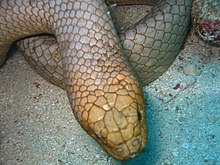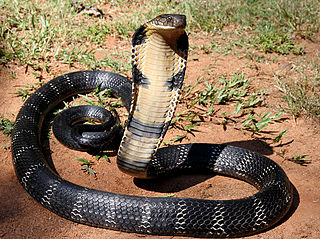
Elapidae is a family of venomous snakes characterized by their permanently erect fangs at the front of the mouth. Many members of this family are also recognized by their threat display of rearing upwards while spreading the neck-flap. Elapids are endemic to tropical and subtropical regions around the world, with terrestrial forms in Asia, Australia, Africa, and the Americas and marine forms in the Pacific and Indian Oceans. Members of the family have a wide range of sizes, from the 18 cm (7.1 in) white-lipped snake to the 5.85 m king cobra. Most species have neurotoxins in their venom which is channeled by their hollow fangs, while some may contain other toxic components in various proportions. The family includes 55 genera with some 360 species and over 170 subspecies.

Acanthophis is a genus of elapid snakes. Commonly called death adders, they are native to Australia, New Guinea and nearby islands, and are among the most venomous snakes in the world. Despite their common name, they are not adders at all and belong to the Elapidae family. The name of the genus derives from the Ancient Greek akanthos/ἄκανθος ('spine') and ophis/ὄφις ('snake'), referring to the spine on the death adder's tail.
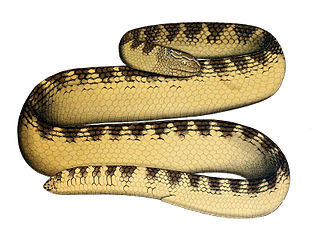
Aipysurus eydouxii, commonly known as the beaded sea snake, marbled seasnake, or spine-tailed seasnake, is a species of sea snake in the family Elapidae. This species of snake is unusual amongst sea snakes in that it feeds exclusively on fish eggs. As part of this unusual diet, this species has lost its fangs, and the venom glands are almost entirely atrophied.

Hydrophis brookii is a species of venomous sea snake in the subfamily Hydrophiinae of the family Elapidae. The species is native to bodies of water in Southeast Asia.

Hydrophis curtus, also known as Shaw's Sea Snake, short sea snake, but often includes Hydrophis hardwickii is a species of sea snake. Like most Hydrophiinae sea snakes, it is a viviparous, fully marine, and front fanged elapid that is highly venomous. It is collected for a variety of purposes including human and animal food, for medicinal purposes and for their skin.

Sea snakes, or coral reef snakes, are elapid snakes that inhabit marine environments for most or all of their lives. They belong to two subfamilies, Hydrophiinae and Laticaudinae. Hydrophiinae also includes Australasian terrestrial snakes, whereas Laticaudinae only includes the sea kraits (Laticauda), of which three species are found exclusively in freshwater. If these three freshwater species are excluded, there are 69 species of sea snakes divided between seven genera.

Pseudechis is a genus of venomous snakes in the family Elapidae. It contains the group of elapid species commonly referred to as the black snakes. Species of Pseudechis are found in every Australian state with the exception of Tasmania, and some species are found in Papua New Guinea. They inhabit a variety of habitat types, from arid areas to swampland. All species are dangerous and can inflict a potentially lethal bite. Most snakes in this genus reach about 2 m (6.6 ft) in total length, and vary in colour. Some species are brown, whereas others are black. The most recognisable and widespread species in the genus are the red-bellied black snake and the mulga snake. These snakes feed on lizards, frogs, birds, small mammals, and even other snakes. All species of Pseudechis lay eggs with the exception of the red-bellied black snake P. porphyriacus which is viviparous. The genus Pailsus is a synonym of Pseudechis, and more work is needed to understand species limits among the smaller species of the group.

Hydrophis is a genus of sea snakes, venomous snakes in the subfamily Hydrophiinae of the family Elapidae. Species in the genus Hydrophis are typically found in Indo-Australian and Southeast Asian waters. Currently, around 36 species are recognized as being valid.

Aipysurus laevis is a species of venomous sea snake found in the Indo-Pacific. Its common names include golden sea snake, olive sea snake, and olive-brown sea snake.
Aipysurus duboisii, also known commonly as Dubois' sea snake and the reef shallows sea snake, is a species of venomous snake in the subfamily Hydrophiinae of the family Elapidae. Its geographic range includes Papua New Guinea, New Caledonia and the northern, eastern and western coastal areas of Australia, that is the Coral Sea, Arafura Sea, Timor Sea and Indian Ocean. It lives at depths up to 80 meters in coral reef flats, sandy and silty sediments which contain seaweed, invertebrates and corals or sponges that can serve as shelter. It preys upon moray eels and various fish that live on the seafloor, up to 110 cm in size. A. duboisii is viviparous, giving birth to live young rather than laying eggs. It displays medium aggressiveness, i.e., will bite if provoked, but not spontaneously. The fangs are 1.8 mm long, which are relatively short for a snake, and the venom yield is 0.43 mg. Aipysurus duboisii is a crepuscular species, meaning that it is most active at dawn and dusk.

The yellow-bellied sea snake is a venomous species of snake from the subfamily Hydrophiinae found in tropical oceanic waters around the world except for the Atlantic Ocean. For many years, it was placed in the monotypic genus Pelamis, but recent molecular evidence indicates it lies within the genus Hydrophis.
Emydocephalus is a genus of sea snakes, also known as turtle-headed sea snakes, in the family Elapidae. Unlike most sea snakes, all species of Emydocephalus, have an absence of teeth on their dentary and palatine bones, and lack venom, making them the only non-venomous elapids. The dentary and palantine bones bear only a row of papillae. Emydocephalus does, however, bear fangs and many small pterygoid teeth. This reduced dentition is due to their diet consisting almost entirely of fish eggs.
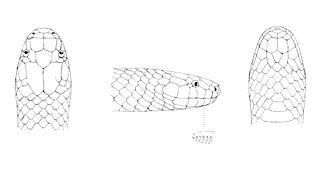
Toxicocalamus is a genus of snakes in the family Elapidae. The genus is endemic to New Guinea.
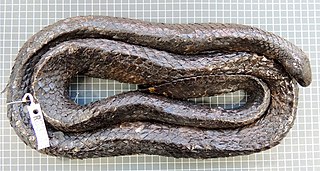
Aipysurus apraefrontalis, commonly known as the short-nosed sea snake or Sahul reef snake, is a critically endangered species of venomous sea snake in the family Elapidae, which occurs on reefs off the northern coast of Western Australia. English herpetologist Malcolm Arthur Smith described the species in 1926 from a specimen collected on the Ashmore Reef.
Hydrelaps is a monotypic genus of venomous sea snake in the family Elapidae. The genus contains the sole species Hydrelaps darwiniensis, also commonly known as the black-ringed mangrove snake, the black-ringed sea snake, Darwin's sea snake, and the Port Darwin sea snake. The species is native to Australia and New Guinea.
Aipysurus fuscus, commonly known as the dusky sea snake or Timor Reef snake, is a species of sea snake in the family Elapidae. It is found in the Timor Sea between Australia, Indonesia and East Timor and has been classified as endangered.

The slender-necked sea snake, also known commonly as Cogger's sea snake, is a species of marine venomous snake in the subfamily Hydrophiinae of the family Elapidae. The species is native to waters around western Australia and the southern Pacific Ocean.

The Elapoidea are a superfamily of snakes in the clade Colubroides, traditionally comprising the families Lamprophiidae and Elapidae. Advanced genomic sequence studies, however, have found lamprophiids to be paraphyletic in respect to elapids. In describing the subfamily Cyclocorinae, Weinell et al. (2017) suggested some or all subfamilies of Lamprophiidae should be reevaluated at full family status as a way to prevent the alternative, which is classifying them as elapids. This was followed in later studies such as Zaher et al. (2019).
Aipysurus mosaicus is a species of snake found in coastal seas of Australia. It is commonly known as the mosaic sea snake.
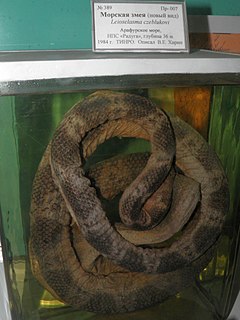
Hydrophis czeblukovi, also known commonly as the fine-spined sea snake, the geometrical sea snake, and the geometrical seasnake, is species of venomous snake in the subfamily Hydrophiinae of the family Elapidae. The species is native to waters off northern Australia.
